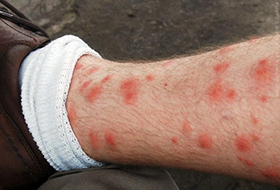By Allen Smith, Texas A&M Forest Service
Trombiculosis is a rash or infestation caused by trombiculid mites, more commonly known as chiggers. We all have suffered from this malady at some time. Be informed and aware of how you can avoid future bouts of trombiculosis.
 Chiggers are not insects but mites, and thus arachnids. They are distributed worldwide
and found most often in temperate woodlands, fields and low lying moist places, though they can also occur in drier places like lawns or
golf courses. Early summer is prime time for chiggers as vegetation is heaviest. They are also present and active during summer and early
fall. Ground temperatures need to range from 77 to 86 degrees for the insects to be active while temperatures colder than 42 degrees
result in chigger mortality.
Chiggers are not insects but mites, and thus arachnids. They are distributed worldwide
and found most often in temperate woodlands, fields and low lying moist places, though they can also occur in drier places like lawns or
golf courses. Early summer is prime time for chiggers as vegetation is heaviest. They are also present and active during summer and early
fall. Ground temperatures need to range from 77 to 86 degrees for the insects to be active while temperatures colder than 42 degrees
result in chigger mortality.
They undergo a 4-stage life cycle: egg, larva, nymph and adult. The adults have eight legs and feed on plants, presenting no problems to humans. It is the larvae that foresters are so familiar with. The tiny red larvae are nearly microscopic. The largest ones go nearly 1/60 of an inch! Larvae are six-legged and feed on skin cells. Mammals, toads, ground-dwelling birds, box turtles and even some insects suffer from the scourge of chiggers.
The larvae attach themselves to the clothes of people as they come into contact with infested vegetation then crawl onto a patch of exposed skin. Chiggers don’t actually bite their victims; they use their sharp claws to make a tiny hole in the skin, then they inject their saliva into the opening. The digestive enzymes in the saliva dissolve skin cells which the chigger consumes.

Skin surrounding the feeding hole hardens and forms a feeding tube called a stylosome that is actually beneath the skin surface. This is the part that itches so much and makes one want to
“dig” the chiggers out of their skin. This contributes to the misunderstanding that chiggers reside beneath the skin. They do not. Left untreated, chiggers will feed on liquefied skin cells for days or weeks.
The initial “bite” is not noticed but symptoms, characterized by intense itching start 1-3 hours after feeding begins. The area of the “bite” may form a reddened pustule or blister. Intense itching usually occurs for 1-2 days following the “bite” and may last for up to 2 weeks.
Scratching of the wound can lead to infection which will extend the pain and sadness associated with chiggers “bites”. Chiggers in North America are NOT vectors of disease but a species that occurs in East Asia and the South Pacific carries the bacterium that causes scrub typhus. Men who get “bitten” in the groin area are at risk of contracting a condition known as “summer penile syndrome”. This may last for few days or up to a few weeks and is characterized by swelling, itching and trouble urinating. A physician should be consulted if this happens to you.

Chigger problems can be reduced by the liberal application of DEET insecticide or the impregnation of permethrin into the clothing. Treating the lower legs and ankle areas is crucial. Long pants and long-sleeved shirts are recommended to minimize the possibility of being “bitten”. Tucking pant legs into tall socks or boots will eliminate the exposed skin that the larvae seek. A common myth is that chiggers seek out areas of the skin where clothing is tightest (ankles, waists, under bras, etc.), this is not true. Rather, the chiggers will seek thin exposed skin, crawling until the hit a restriction such as a belt or bras. Most “bites” occur around the ankles, crotch, groin, armpits and behind the knees.
Treatment for exposure to chiggers includes taking a warm, soapy shower as soon as possible after being in chigger country. The skin should be scrubbed vigorously. Clothing should be washed in hot soapy water and boots, including the insides should be wiped as clean as possible. Over the counter treatments like calamine lotion or corticosteroid creams will alleviate itching. Antihistamines like Benadryl can be taken orally to relive symptoms. Other itch-relief treatments that might work include cool showers, cool compresses or using bath products that have colloidal oatmeal as an ingredient.
Treatment of chigger problems using many home remedies like soaking in a bleach bath or applying fingernail polish to suffocate the chigger DO NOT WORK as the chigger is not attached to the victim. The itching comes from the stylosome.
Submitted by:
Allen Smith
Regional Forest Health Coordinator
1203 W. Loop 281 Ste. B102
Longview, TX 75604
903-297-5094